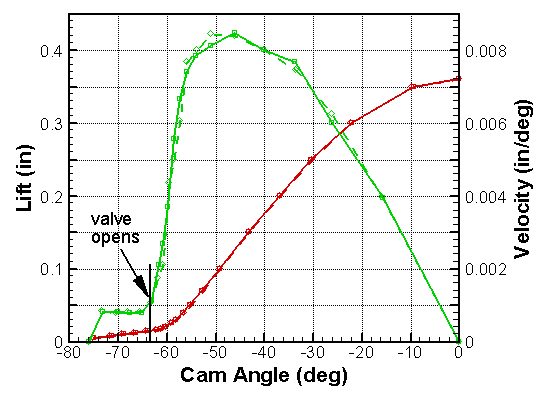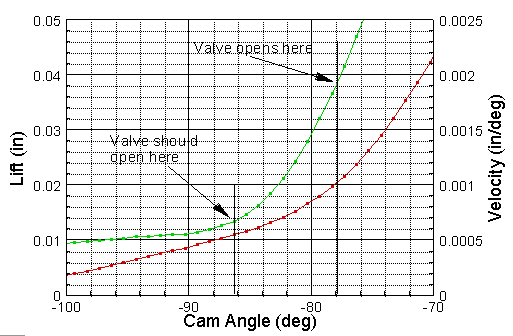How to Determine Valve Lash
 For solid lifters, you need to know the valve lash.
Since the purpose of a ramp is to avoid a high velocity collision,
the valve should open and close at the end of the ramp. The
cam in the graph at right has a typical constant velocity ramp, and the desired valve
opening point is indicated. This point occurs at a lift of
0.0147. As the cam rotates, it will first reach a lift that removes
all slack within the valve train. Due to clearances around the
bearings and flexibility within the valve train, there will then be
a brief lift period before the valve opens. We call this valve
train squish. For a stiff direct attack system (OHC,
flathead), the squish is perhaps 0.002 inches, while for a more
flexible OHV system with higher spring pressures it might be as high
as 0.004. To determine the valve lash, subtract the squish from the
desired valve opening lift. The cam in the graph is for a
flathead, using squish of 0.002 the valve lash should be 0.0127 or 0.013. The
exhaust could be set a couple thousandths larger to allow for
thermal expansion. The Ford Model A/B and early V8 cams (<1949) all had ramps that ended at
0.015 lift (see Cam Design
History), and Ford recommended a valve lash of 0.012 on the intake
and 0.014 on the exhaust.
For solid lifters, you need to know the valve lash.
Since the purpose of a ramp is to avoid a high velocity collision,
the valve should open and close at the end of the ramp. The
cam in the graph at right has a typical constant velocity ramp, and the desired valve
opening point is indicated. This point occurs at a lift of
0.0147. As the cam rotates, it will first reach a lift that removes
all slack within the valve train. Due to clearances around the
bearings and flexibility within the valve train, there will then be
a brief lift period before the valve opens. We call this valve
train squish. For a stiff direct attack system (OHC,
flathead), the squish is perhaps 0.002 inches, while for a more
flexible OHV system with higher spring pressures it might be as high
as 0.004. To determine the valve lash, subtract the squish from the
desired valve opening lift. The cam in the graph is for a
flathead, using squish of 0.002 the valve lash should be 0.0127 or 0.013. The
exhaust could be set a couple thousandths larger to allow for
thermal expansion. The Ford Model A/B and early V8 cams (<1949) all had ramps that ended at
0.015 lift (see Cam Design
History), and Ford recommended a valve lash of 0.012 on the intake
and 0.014 on the exhaust.
Determining valve lash for an OHV cam is more complicated due to the rocker ratio. For the Triumph TR4 cam shown at the top of the Cam Design page, the ramp ends (i.e. the velocity curve turns up) at a lift of 0.010. Using 0.003 for the squish and the rocker ratio of 1.5:1, the valve lash should be (0.010 - 0.003)*1.5 = 0.0105. Triumph recommended a lash of 0.010. Many manufacturers recommend 0.002 larger exhaust lash for the TR4, which is all steel or iron. Depending on the thermal expansion characteristics of the materials (aluminum, steel), it may be necessary to use a somewhat larger valve lash. The lash should be checked both hot and cold to determine the effect of thermal expansion.
Not all cams have a constant velocity ramp like these two examples. Some ramps have an increasing velocity (positive acceleration), but there is a point at which the velocity starts to increase rapidly. This should occur when the velocity is not excessively large (usually < 0.0010 in/deg). The point of rapid increase in the velocity is the point where the valve should open.
Another Example
 When
investigating racing cams for our vintage race Triumph (see
Triumph Cams), we found
three cams where the cam card recommended a valve lash that was
significantly beyond the ramp. This leads to the valve opening
and closing on the flank of the cam with a high velocity impact.
The high velocity impact of the valve hitting the seat is not good
for valve seats, and high spring pressure is needed to avoid valve
bounce after it hits the seat.
When
investigating racing cams for our vintage race Triumph (see
Triumph Cams), we found
three cams where the cam card recommended a valve lash that was
significantly beyond the ramp. This leads to the valve opening
and closing on the flank of the cam with a high velocity impact.
The high velocity impact of the valve hitting the seat is not good
for valve seats, and high spring pressure is needed to avoid valve
bounce after it hits the seat.
The graph at the right shows the lift and velocity in the opening ramp area for one of the three cams which opened on the flank. The cam closing is a mirror image. For this cam the cam card recommended a valve clearance of 0.026 inches, so the valve will open at approximately:
(0.026)/(1.5) + 0.003 = 0.0203
The graph shows a gradually increasing ramp velocity of about 0.0005 in/deg and then a rapidly increasing velocity on the flank. The point where the valve will open is indicated on the graph. It corresponds to a velocity of 0.0019 and an acceleration which is 70% of the maximum acceleration. This must be hard on valve seats. If the lash were correctly specified, the valve would open where indicated with a lift of about 0.011 and a velocity of about 0.0007. The valve lash should be about 0.012 not 0.026. Using the correct lash increases the seat-to-seat duration by 32 degrees, with only a small change in the 0.050 duration. As explained on the Cam Performance page, this increased seat-to-seat duration would be detrimental to performance.
This example shows another reason you should take the time to degree your cam.